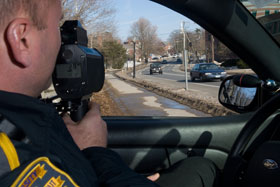  |
| HOME | THIS ISSUE | CALENDAR | PATENTS | BACK ISSUES | < BACK | NEXT > |
Measures explored to improve safety on North Eagleville Road by Richard Veilleux - February 26, 2007 |
||||
| A combination of education, enforcement, and design will be needed to make North Eagleville Road – and other roads that cut through campus – safer for pedestrians and motorists, the Capital Projects Planning Advisory Committee heard on Feb. 15. Barry Feldman, vice president and chief operating officer and co-chair of the committee, told the group that UConn has hired a consulting firm, Earthtech, to perform a traffic study on North Eagleville Road.
One immediate outgrowth of the effort will be new signage, possibly lime green, which should be erected within the next few weeks. “The Department of Transportation has been very sympathetic and cooperative,” Feldman told the committee, noting that North Eagleville Road is a state-owned road, and the state DOT must approve any changes to it. The road is also known as Route 430. Feldman, UConn engineers, DOT engineers, UConn public safety officials, and engineers from Connecticut Light & Power (CL&P), the company that owns the street lights on the road, have been meeting since shortly after Carlee Wines, a UConn freshman from New Jersey, was struck and killed while crossing the road in the early hours of Jan. 20. Feldman said Earthtech has already developed traffic and pedestrian counts on North Eagleville Road, and the results, while stunning, are not surprising: approximately 12,000 vehicles travel the road daily, and a nearly equal number of students cross the road each day. He also said the firm’s tests on the street lights that line the road indicated the amount of lumens distributed from the lights was “spotty, at best.” He said CL&P may change some of the fixtures in the near future. UConn officials, aware that North Eagleville Road is one of the most used thoroughfares on campus, in fall 2004 banned parking on the road to improve sightlines for drivers and pedestrians alike. There also have been discussions about whether to install speed bumps on the road, but the DOT generally will not approve speed bumps on public roads, Feldman said. He noted that a number of ideas are being discussed, and that much can be learned from other university campuses. In the longer term, he added, a landscape architect would look at the crosswalks with an eye toward channeling students into several major crossings rather than using the nine that currently exist. But at this time, he said, “there has been no suggestion that major, significant changes to the roadway design would be warranted.” Since the accident, UConn police have increased their use of laser speed enforcement devices on North Eagleville Road – a tool that serves two of Feldman’s three goals, education and enforcement. “We’re normally very active with enforcement on that road anyway,” said Major Ronald Blicher of the UConn Police, noting that between mid-November and mid-January, police made more than 750 traffic stops on the road. Many of these led to warnings or tickets for infractions ranging from traveling too fast to driving under the influence. Feldman said he hopes to receive a complete report by the end of March. |
| ADVANCE HOME |

